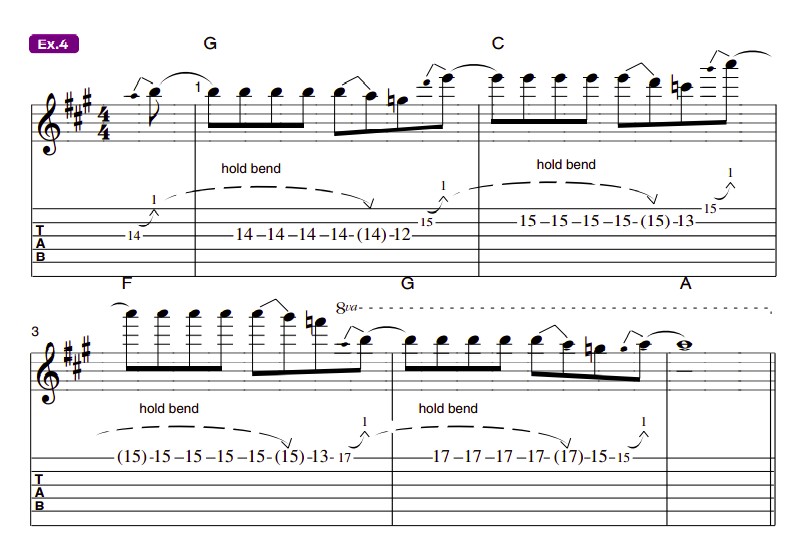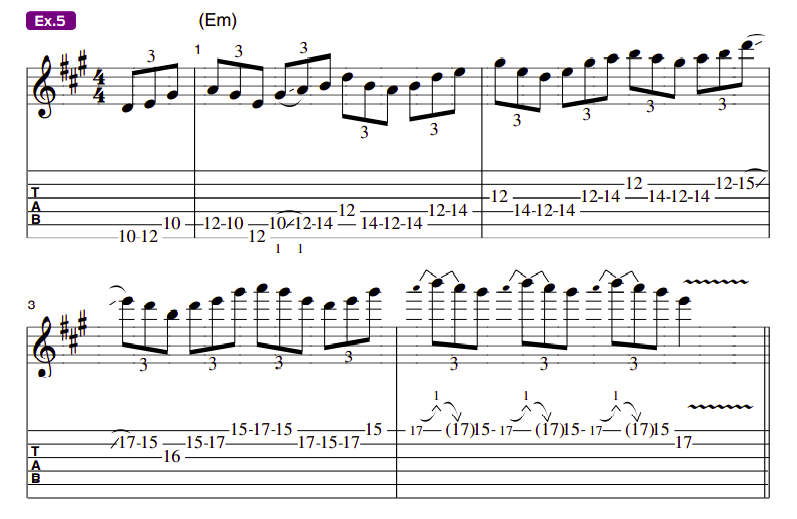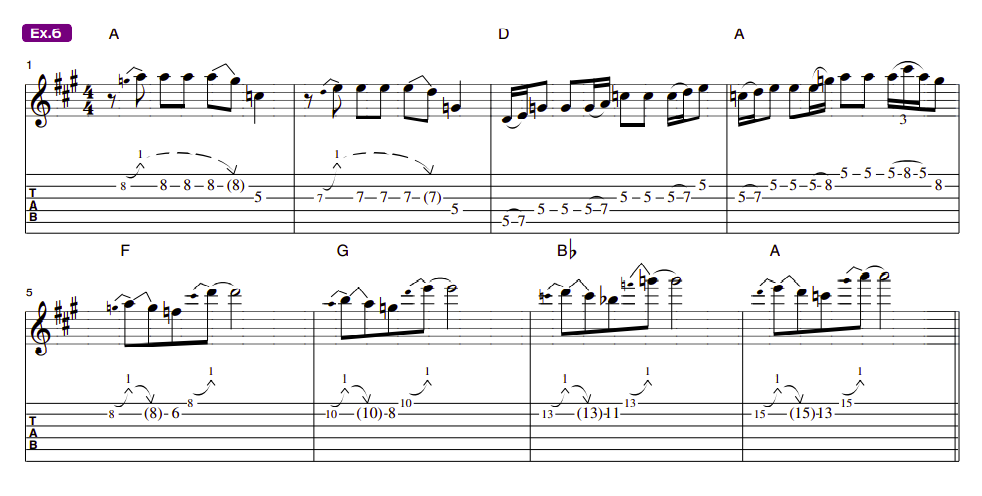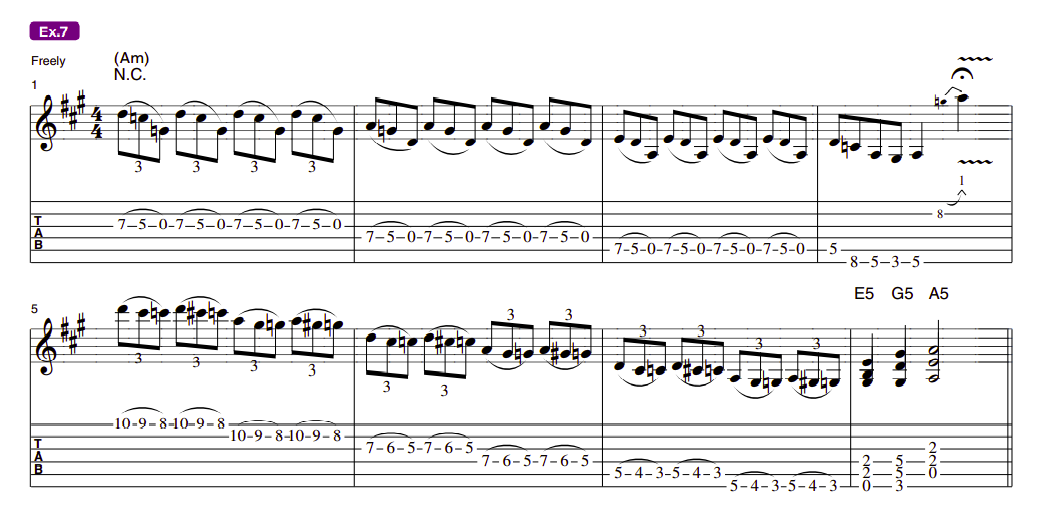Watch Ace Frehley Ripping Up the Fretboard and Learn How to Shred Kiss-Style
This revealing lesson exploring Ace Frehley’s fiery pentatonic runs.

If you grew up in the 1970s and were smitten by loud, fast rock and roll, there’s a solid chance it was Kiss’s Ace Frehley who first inspired you to pick up a guitar – or, at the very least, sparked your urge to mime an air axe with unabashed gusto.
Kiss took showmanship into the stratosphere with their cooler-than-hell futuristic outfits, quasi-superhero makeup and tightly choreographed concert extravaganzas that included fire breathing, smoking electric guitars and tons of pyro.
All spectacle aside, however, the band played tight, solid hard rock and wrote some damn catchy tunes, too. And while bassist/vocalist Gene Simmons and rhythm guitarist/vocalist Paul Stanley have kept an incarnation of Kiss going since the early ’70s, it’s the original lineup, which lasted until the departure of Frehley and drummer/vocalist Peter Criss in the early ’80s, that most fans consider the definitive one.
A wide range of guitarists, including Pearl Jam’s Mike McCready, Pantera’s Dimebag Darrell, Rage Against the Machine’s Tom Morello and Guns N’ Roses’ Slash have cited Kiss – and Frehley in particular – as a key early influence.

In his Kiss heyday, Frehley relied heavily on minor pentatonic box patterns, often approaching them with a clever logic based on sequenced patterns and impressive displays of flash. Before we begin, make sure you’re familiar with three specific pentatonic forms. Ex. 1b shows the familiar root-position Box 1 form, which is based on the first note of the scale (the root), starting on the low E string.
Examples 1a and 1c detail, respectively, the Box 5 shape below the root, starting on the fifth note, or degree, of the minor pentatonic scale, which is the minor, or “flatted,” seventh; and Box 2, which begins on the scale’s second degree, the minor, or “flatted,” third.
Ace likes to weave in and out of these three adjacent, overlapping patterns, using Box 1 as a foundation. We’ve illustrated the boxes here in the key of A minor, which was a common key in early Kiss songs, although the group would often tune their instruments down a half-step, to Eb standard.
All the latest guitar news, interviews, lessons, reviews, deals and more, direct to your inbox!
You can easily transpose the visual and physical shapes to any other key simply by shifting the box patterns up or down the fretboard to different tonal centers.

Ex. 2 is based on the C# minor pentatonic scale (C# E F# G# B) and is inspired by a sequenced two-string pattern Frehley delivers during his solo in the frequent Kiss concert opener “I Stole Your Love.” Notice how the pick-hammer-pull trill pattern works its way up through the Box 1 shape.

Ex. 3 is a similar C# minor pattern, this time incorporating the cool, low-string perfect-fourths double-stops that provide heft to the song’s main riff.

Ex. 4 is based on a lead break Ace plays in “King of the Nighttime World.” The song is mostly in the key of D, but the progression under the chorus and instrumental break works its way through a series of chords that are fourths apart.
Instead of changing keys and scale patterns, however, Frehley cleverly sequences a tasty bent-note motif up the top three strings of a Box 2 D minor pentatonic (D F G A C) shape to smoothly sail through the changes.

Ace’s guitar break at the beginning of “Love Gun” is arguably one of the most exciting and propulsive musical moments in Kiss’s early catalog, and although Ex. 5 is not an exact transcription, it’s based on a similar idea: a sequenced triplet motif that starts on the low strings of a Box 5 E minor pentatonic scale (E G A B D) and ascends upward through the next two forms (Box 1 and Box 2), climaxing with a series of whole-step bends on the high E string within the Box 2 shape. Pick cleanly and pay attention to the fret-hand fingerings to make the position shifts as smooth as possible.

Loosely based on Frehley’s epic lead in “Firehouse,” Ex. 6 demonstrates three of its key components: articulated bend-and-release moves in the first two bars, ascending hammer-ons in bars 3 and 4, and a four-note melodic riff sequenced up the neck in the final four bars.
Bars 1-4 are played within the A minor pentatonic pattern. In bars 5-8, a sequenced pattern ascends through different tonal centers and breaks with the scale, but the physical shape remains consistent as it moves up the neck to match each chord.

For Ex. 7, we drew inspiration from Ace’s unaccompanied solo at the end of “Shock Me,” which was a highlight of almost every Kiss concert back in the ’70s. Like Frehley, here we predominantly stick with A minor pentatonic forms.
We’ve transcribed the solo in 4/4, but in concert the Space Ace would often play the phrases quite freely. Kiss fans expected plenty of flash and spectacle, and Ace certainly delivered the goods, so let’s begin with some ear-grabbing rapid-fire double-pull-off triplets to open strings, grounded in the Box 1 A minor scale pattern (bars 1-4).
Next, use the bend at the end of bar 4 to transition to the high strings of the Box 2 A minor pentatonic form in bar 5, which features a chromatic passing tone and double pull-off on each string. In bar 6, this lick is displaced an octave lower to the middle two strings of the Box 1 shape, and, in bar 7, another octave lower to the bottom two strings in the Box 5 shape, before finally resolving with a few boldly articulated power chords in bar 8.
These are some cool licks for sure, but the raddest part of Ace’s in-concert feature is still the smoke and fire that shot from his Les Paul’s dummy rhythm pickup cavity during the solo’s climax. For that level of showmanship, you’ll have to experience Ace and Kiss in concert for yourself.
